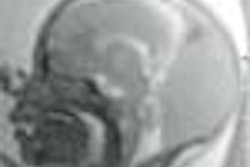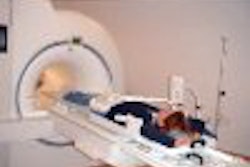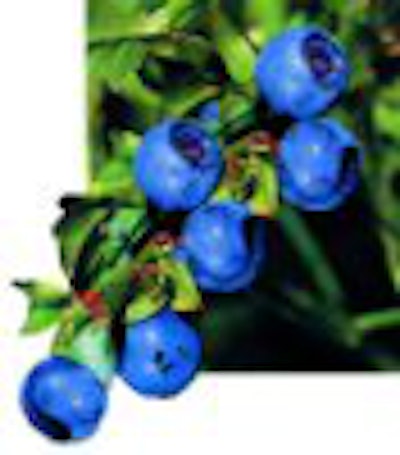

Suppressing the digestive tract in MR urography imaging is critical for analyzing a dilated urinary tract, generally accomplished by administering a negative contrast agent. While commercial negative contrast preparations achieve excellent results, administering these agents to infants and small children can sometimes be difficult and, in some countries, is not permitted for children under 15 years old.
A group of French researchers have turned to a natural contrast agent for their pediatric urography patients, one that is nontoxic, easy to use, inexpensive, and palatable: blueberry juice.
Dr. Edith Rivoal and colleagues from the Centre Hospitalier Intercommunal de Cornouaille in Quimper-Concarneau, France, presented their results in a poster entitled "Blueberry juice as a negative contrast agent in pediatric MR urography," at the 2001 European Congress of Radiology in Vienna.
Rivoal said she first heard about using blueberry juice as contrast during a 1991 ECR scientific session that focused primarily on the efficacy of MR urography with rapid acquisition with relaxation enhancement (RARE).
During the presentation, a discussion of the paramagnetic effects of blueberries piqued her interest, Rivoal told AuntMinnie.com.
So in March 1999, when the Centre Hospitalier Intercommunal de Cornouaille acquired a Magnetom Harmony 1-tesla MR scanner (Siemens Medical Solutions, Iselin, NJ), Rivoal and a technologist put a teaspoon of blueberry marmalade in a glass of water and imaged it in the MR. They were both surprised to discover that the hypersignal of the water was entirely negative, she said.
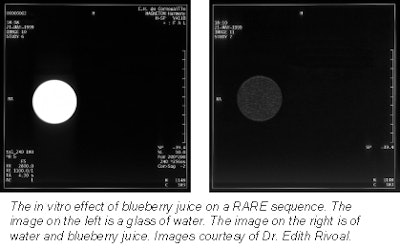 |
The group’s research revealed that blueberry juice is naturally rich in manganese (Mn++) at 30 mg per liter. It also produced a hypersignal (positive contrast) in T1-weighted images and a hyposignal (negative contrast) in T2-weighted images. The researchers then set out to define an imaging protocol with blueberry juice.
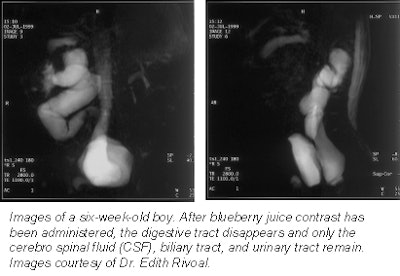 |
They determined that an hour before an examination, a fasting patient should ingest a contrast mixture of three parts milk to one part pure blueberry juice. For infants, the contrast agent is administered via a baby bottle.
Rivoal noted that the procedure had a calming effect on the child, induced a good hydration state, and increased diuresis for imaging. For imaging infants who are still breast feeding, she recommended the child be given diluted, sweetened blueberry juice before nursing.
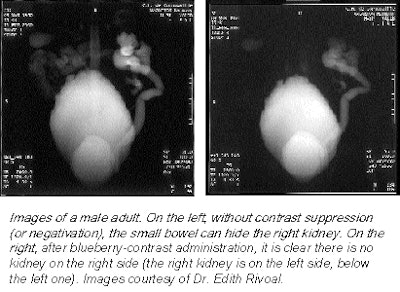 |
Blueberry juice has been successfully used as a contrast agent in the past. Researchers from Japan found that it "improved confirmation of gastroduodenal tract regardless of field strength and could be adapted for fast spin echo" MRI (Nippon Igaku Hoshasen Gakkai Zasshi, June 1994, Vol. 54:6, pp.539-541).
Swiss radiologists at the University Hospital Zurich tested the feasibility of MR gastrography following the oral administration of gadolinium-enriched blueberry juice. They found that the mixture permitted exoscopic and virtual endoscopic viewing of the stomach (European Radiology, January 1999, Vol. 9:1, pp.73-77).
Blueberry juice improved common bile duct and main pancreatic duct depiction in MR cholangiopancreatography, according to a study in the Journal of Computer Assisted Tomography (March-April 2000, Vol. 24:2, pp. 229-234).
Rivoal said her group is the first to use blueberry juice for pediatric MR urography, and that the protocol is used regularly at her institution. Rivoal added that she has successfully used blueberry jam on rye bread as a contrast agent for MRI of adults and older children, noting that rye is rich in manganese as well.
By Jonathan S. BatchelorAuntMinnie.com staff writer
April 26, 2001
Related Reading
Pediatric Radiology: The Requisites, April 11, 2001
CT narrows causes of pediatric chest trauma in an emergency setting, March 15, 2001
CT, MRI helps pinpoint rare pancreatic alteration cystic fibrosis patients, March 5, 2001
Study sparks fears over kids’ exposure to CT radiation, February 13, 2001
3-D ultrasound defines facial clefting prenatally, October 12, 2000
Click here to post your comments about this story. Please include the headline of the article in your message.
Copyright © 2001 AuntMinnie.com




